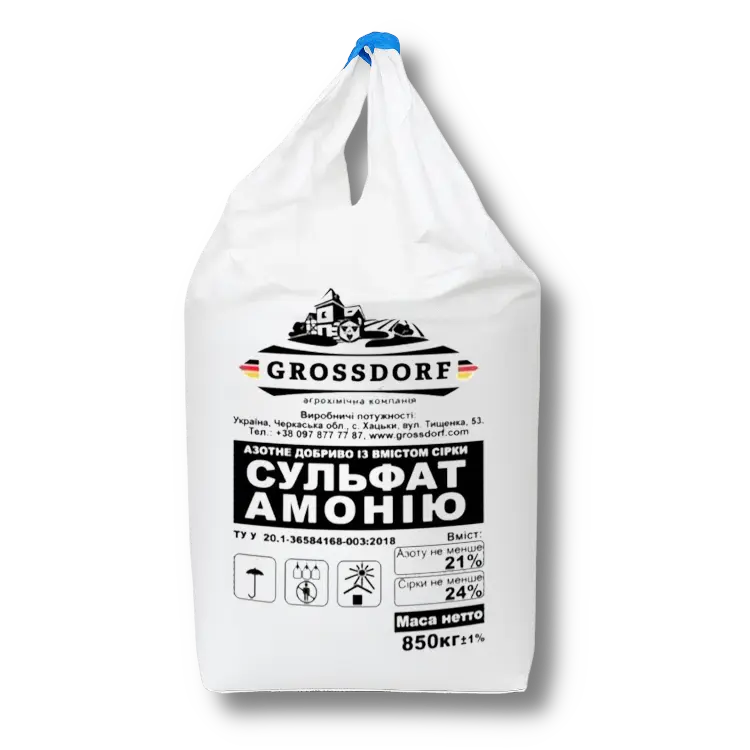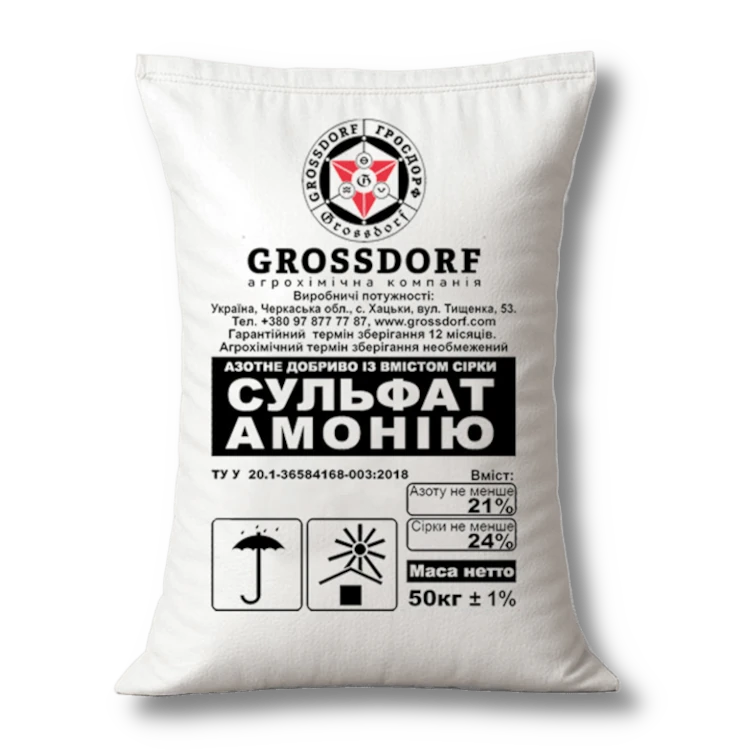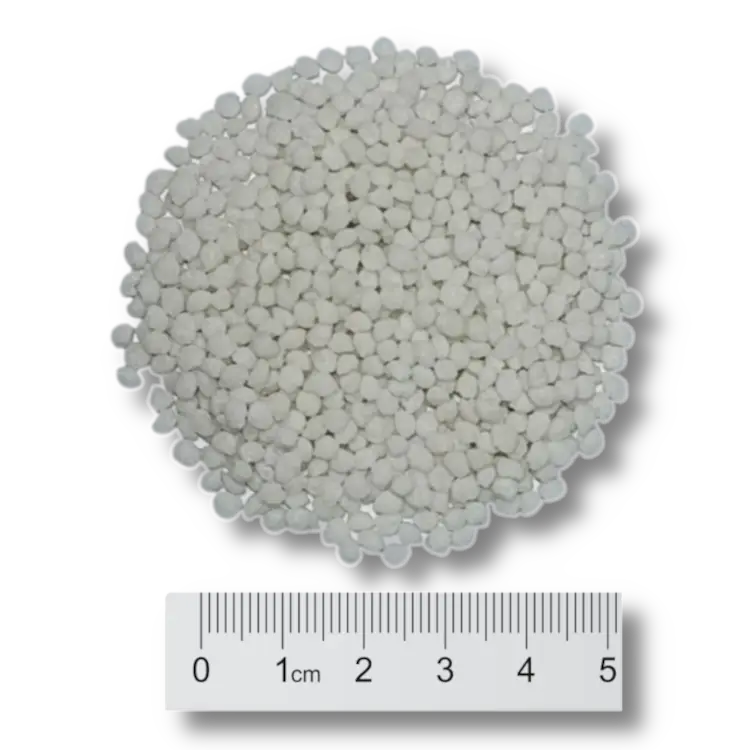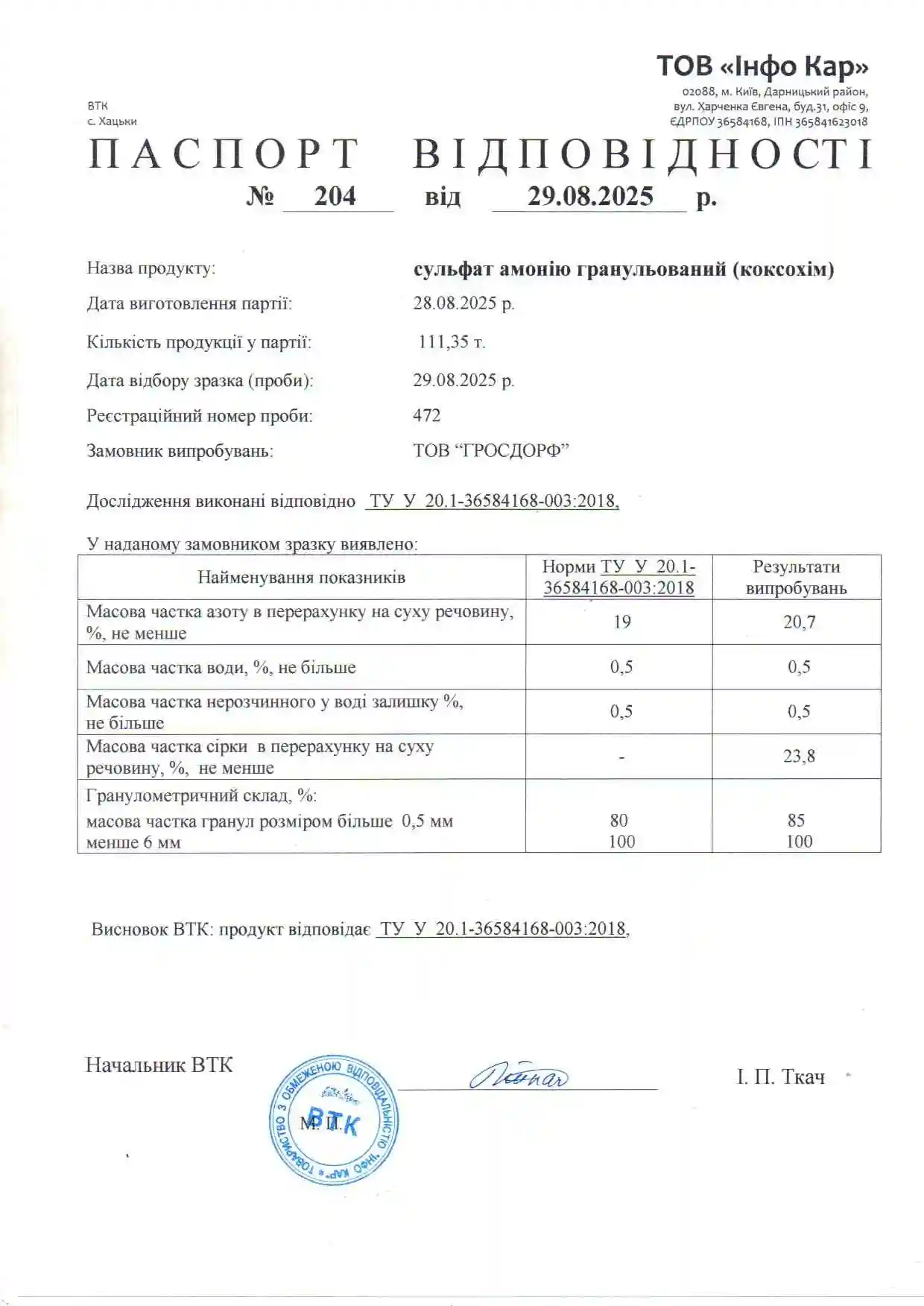Ammonium sulfate
Ammonium sulfate
ТU U 20.1-36584168-003:2018
Sales/packaging terms: EXW, FCA, big bag, 50 kg
Delivery terms: by own transport across Ukraine or self-pickup
Khatsky, Cherkasy region | Mayaky, Vinnytsia region | Poltava | Ternopil |
|---|---|---|---|
12 000 | 12 000 | 12 500 | 12 500 |
Ammonium sulfate is a high-quality nitrogen-sulfur fertilizer obtained as a result of the purification of coke chemical production products. It contains 21% nitrogen in ammonium form and 24% sulfur in sulfate form, which provides complete but stable nutrition and balanced protein metabolism.
Due to its high granule strength, the fertilizer is ideally suited for mechanical application with all types of spreaders. It has a uniform particle size distribution and remains free-flowing under proper storage conditions
Recommended use:
- all agricultural crops: cereals, legumes, oilseeds, vegetables, forage crops;
- especially effective for crops with a high need for sulfur: rapeseed, soybeans, mustard, garlic, onions;
- base application, localized in-row placement, pre-sowing application;
- on sulfur-deficient soils, for crops with increased sulfur demand;
- suitable for blending with other fertilizers (after compatibility testing).
Advantages:
- high chemical purity — ideal for sensitive crops and controlled environments;
- uniform application — ideal for modern agricultural machinery;
- improved crop quality — higher protein, gluten, and oil content;
- long-lasting nitrogen effect and enhanced sulfur uptake;
- low phytotoxicity — safe for young plants;
- effective even under adverse weather conditions.
Limitations and warnings:
- do not store near acids, alkaline substances, or organic fertilizers;
- do not mix with lime or calcium fertilizers without a compatibility test;
- do not allow moisture to build up — caking is possible.
Appearance and color: free-form granules from white to dark brown
| Mass fraction of nitrogen in terms of dry matter, not less, % | 19 |
| Mass fraction of fraction larger than 0.5 mm, % | 80 |
| Mass fraction of fraction smaller than 6 mm, % | 100 |
| Mass fraction of insoluble residue in water, not more than % | 0,5 |
- store in dry, well-ventilated facilities, protected from direct sunlight, with relative air humidity not exceeding 70%. Place bags on pallets at least 15 cm above the floor, arranged in a single layer;
- packaging (bags, big bags) must be tightly sealed to prevent moisture ingress;
- permissible storage temperature: from –20 °C to +35 °C (avoid exposure to high humidity, as this may cause caking or condensation — loosen before use if necessary);
- avoid contact with acids, alkaline substances, organic compounds, or other fertilizers that may cause a chemical reaction;
- in case of prolonged storage, periodically loosen the product to prevent clumping.
| Culture | Application period /rate, kg/are | Special application conditions | |||
|---|---|---|---|---|---|
| Pre-sowing cultivation | First fertilization | Second fertilization | Third fertilization | ||
| Cereal сrops | |||||
| Winter wheat | 1,4 | - | - | - | applied in autumn before plowing or deep digging |
| - | 1,0-2,4 | - | - | spring tillage | |
| - | - | 1,0-2,9 | - | beginning of the tube | |
| Spring barley | 1,4-4,3 | - | - | - | before pre-sowing cultivation |
| - | 1,4 | - | - | no later than the appearance of 1-2 leaves in the presence of moisture | |
| Maize | 2,6-5,7 | - | - | - | on heavy soils in areas of unstable or insufficient moisture, apply in the fall under plowing |
| 2,9-4,3 | - | - | - | on heavy soils in areas of unstable or insufficient moisture, apply in spring for cultivation | |
| 1,4 | - | - | in the 3-5 leaf phase in the presence of moisture | ||
| Oats | 1,43-4,3 | - | - | - | in spring for replanting cultivation |
| - | 1,4 | - | - | no later than the appearance of 1-2 leaves in the presence of moisture | |
| Industrial crops | |||||
| Sunflower | 3,0 | - | - | - | during primary tillage or before sowing |
| Sugar beet | 5,0 | - | - | - | during primary tillage or before sowing |
| Oilseeds | |||||
| Winter rape | 1,25-3,3 | - | - | - | during autumn (fallow) tillage or before sowing |
| - | 4,0 | - | - | when spring vegetation resumes | |
| - | - | 3,8 | - | in the stem formation phase | |
| - | - | - | 1,9 | in the phase of full budding under conditions of sufficient moisture | |
| Soybeans | 1,4 | - | - | - | during primary tillage or before sowing |
| - | 1,4 | - | - | as needed before flowering begins | |
| Oil flax | 1,9-2,8 | - | - | - | during autumn (fallow) tillage or before sowing |
| - | 0,7-0,8 | - | - | in the fir-tree phase (plants reach a height of 5-10 cm and have 5-6 pairs of leaves) if nitrogen was not applied before sowing | |
| Vegetables | |||||
| Tomatoes | 3,8-7,0 | - | - | - | before plowing or during sowing cultivation, if no further fertilization is planned |
| - | 2,0-4,5 | - | - | when planning fertilization | |
| Peppers | 5,7-6,7 | - | - | - | before plowing or during pre-sowing cultivation, if no further fertilization is planned |
| - | 1,9-3,0 | - | - | when planning fertilization | |
| Zucchini | 4,3-5,7 | - | - | - | before plowing or during pre-sowing cultivation, if no further fertilization is planned |
| - | 2,1-3,6 | - | - | when planning fertilization | |
| Cucumber | 4,0-5,7 | - | - | - | before plowing or during pre-sowing cultivation, if no further fertilization is planned |
| - | 1,0-2,9 | - | - | when planning fertilization | |
| Aubergine | 3,8-5,7 | - | - | - | before plowing or during pre-sowing cultivation, if no further fertilization is planned |
| - | 1,9-3,8 | - | - | when planning fertilization | |
| Potatoes and other root crops | |||||
| Potatoes | 3,0-6,0 | - | - | - | in the fall for plowing or in the spring for cultivation |
| - | - | 0,9 | - | during inter-row cultivation at a bush height of 15-20 cm in the presence of moisture | |
| Table beet | 3,0-4,0 | - | - | - | on heavy and light loamy soils in areas of unstable or insufficient moisture, apply in autumn under plowing or in spring under cultivation |
| - | 0,9 | - | - | row fertilization in the presence of moisture | |
| Carrots | 4,3 | - | - | - | on heavy and light loamy soils in areas of unstable or insufficient moisture, apply in autumn under plowing or in spring under cultivation |
| - | 0,9 | - | - | row fertilization in the presence of moisture | |
| Radish | 4,8 | - | - | - | on light loamy soils in areas of unstable or insufficient moisture, apply in autumn under plowing |
| Onion | 4,3-5,7 | - | - | - | under plowing or into pre-sowing cultivation (if no other fertilizations are planned) |
| 2,4-3,8 | - | - | - | when planning fertilization | |
| Garlic | 2,9-5,7 | - | - | - | under plowing or into pre-sowing cultivation (if no other fertilizations are planned) |
| 2,4-2,9 | - | - | - | when planning fertilization | |
| Fruit trees and berry trees | |||||
| Apple tree | - | 4,5 | - | - | fertilizing in spring before the start of vegetation or from the bud swelling phase to the pink buds phase |
| Pear tree | - | 3,3 | - | - | fertilizing in spring before the start of the growing season/at the beginning of the growing season |
| Cherry tree | - | 5,5 | - | - | spring fertilization before flowering |
| Raspberry | - | 2,9 | - | - | spring fertilization before the start of vegetation |
| Wild Strawberry/Garden Strawberry | - | 2,9 | - | - | spring fertilization before the start of vegetation |
| Blueberries | Fertilize twice a year: at the beginning of the growing season (April) and at the end (August-September). After planting: 2nd year – 1 tbsp. spoon, 3rd year – 2 tbsp. spoon, 4th year – 4 tbsp. spoon, 5th year – 8 tbsp. spoon, 6th and subsequent years – 16 tbsp. spoon or 40–50 g per adult bush | ||||
| Grapes | - | 5,7 | - | - | spring fertilization before the start of vegetation |
| Flowers and lawn grasses | |||||
| Rose | 0,02-0,03 | - | - | - | in the hole when planting |
| - | 0,015-0,020 per 10 liters of water | - | - | in spring, after pruning and before shedding 1 leaf | |
| - | - | 0,03-0,04 | - | during the period of intensive growth before the beginning of mass flowering | |
| Tulips | - | 3,0 | - | - | for plant heights of 5-8 cm |
| Lawn grasses | 2,9 | - | - | in autumn before lawn establishment | |
| - | 2,4 | - | - | as needed, when the soil warms up to 10 C | |
| - | - | 2,4 | - | as needed, from the beginning of May to the end of June | |
The fertilizer application rates were developed by the Department of Agrochemistry and Soil Science of Uman National University of Horticulture under the scientific supervision of Doctor of Agricultural Sciences, Professor Hospodarenko H.M., commissioned by AC Grossdorf. These recommendations are the intellectual property of AC Grossdorf and may be distributed only with proper attribution to the owner.
The provided application rates are generalized and do not replace the need for consultation with an agronomist.




